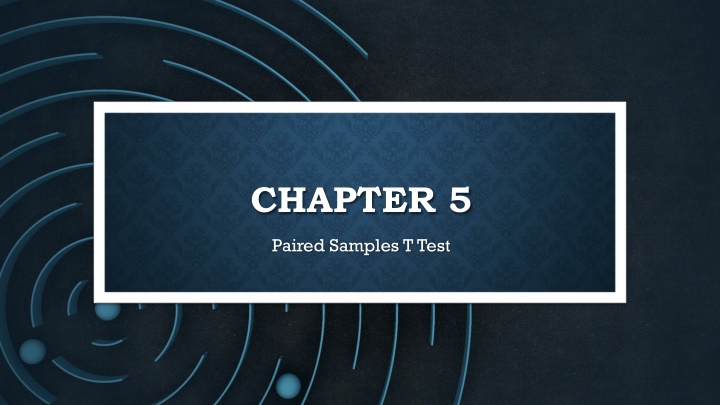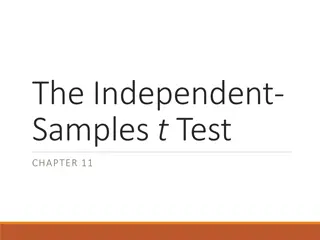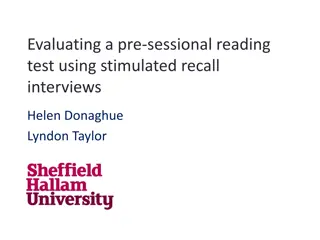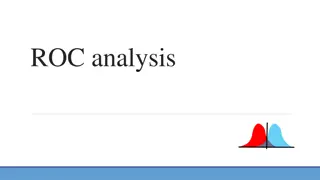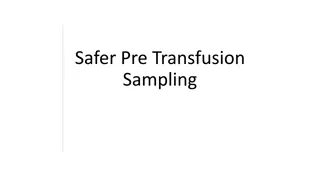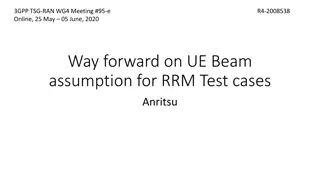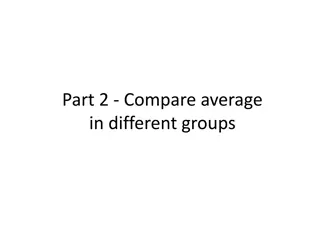Paired Samples T-Test in Healthcare Study
Research on ageism impact on healthcare attitudes through paired samples t-test. Study design, participant details, and results discussed. The use of paired samples t-test in medical research highlighted.
Download Presentation

Please find below an Image/Link to download the presentation.
The content on the website is provided AS IS for your information and personal use only. It may not be sold, licensed, or shared on other websites without obtaining consent from the author.If you encounter any issues during the download, it is possible that the publisher has removed the file from their server.
You are allowed to download the files provided on this website for personal or commercial use, subject to the condition that they are used lawfully. All files are the property of their respective owners.
The content on the website is provided AS IS for your information and personal use only. It may not be sold, licensed, or shared on other websites without obtaining consent from the author.
E N D
Presentation Transcript
CHAPTER 5 Paired Samples T Test
LEARNING OBJECTIVES 1. Teach statistical thinking a. Students will be able to state the null and alternative hypotheses for paired samples t tests b. Students will understand the appropriate use of paired samples t tests c. Students will know how to accurately write the results of paired samples t tests in APA format 2. Focus on conceptual understanding a. Students will understand the distinction between repeated measures and matched pairs designs b. Students will know how to interpret the results of paired samples t tests 3. Students will be able to translate the results of a paired samples t test into real world meaning (i.e., how would you explain the results to someone not taking this course?) 4. Use technology to explore concepts and analyze data a. Students will know how to test that the dataset meets the assumptions needed to run paired samples t tests b. Students will know how to run paired samples t tests in JASP
BACKGROUND (KUSUMASTUTI ET AL., 2017) Research question: If ageism can impact the way people provide healthcare, are there ways to reduce ageism among healthcare providers? In the medical field, they have tried to fight ageism by incorporating care internships for medical students that involve working with older populations, but does this approach work? Design: Students were assigned to older adults in need of intensive care for a two-week internship, and researchers measured their attitudes toward old people before and after the internship Participants: 315 first-year medical students Measures: Attitudes Toward Old People scale Results: A paired samples t test revealed that working closely with older adults resulted in worse attitudes toward older adults after the two-week internship Before: M = 118.4, SD = 17.4 After: M = 112.1, SD = 19.4
LETS THINK ABOUT IT WHY DID THE RESEARCHERS USE PAIRED-SAMPLES T TESTS TO ANSWER THEIR RESEARCH QUESTIONS? WHAT DO THEIR RESULTS MEAN? HOW WOULD YOU IMPROVE THIS STUDY?
INTRODUCTION TO PAIRED SAMPLES T TESTS As with an independent measures t test, a paired samples t test explores differences between the means of two groups of scores The main difference between an independent measures t test and a paired samples t test involves the nature of how those scores are grouped together With an independent measures t test, the two groups of scores are not related to one another (hence, the term independent ) With a paired samples t test, the two groups of scores are related to one another in some way
HOW ARE GROUPS OF SCORES RELATED Typically, in psychology, scores are paired using either a repeated measures design or a matched pairs design With a repeated measures design, observations involve participants who are the same individual tested at two points in time, or under two unique conditions or treatments, on an outcome variable; in this research design, each participant provides two scores on the same dependent measure With a matched pairs design, groups of scores do involve two separate groups of participants, but they are related to one another because the researcher purposefully matches participants on one or more characteristic; both groups of matched participants are then tested on the dependent variable
WHAT IS A PAIRED SAMPLES T TEST? In a paired samples t test, groups of scores are compared by calculating a difference score for the mean of each group In a paired samples t test, a difference score is compared to a value of zero to see if it is different enough from zero to suggest statistical and/or practical significance
WHEN DO RESEARCHERS USE PAIRED SAMPLES T TESTS? Repeated measures design: Is there a change in the dependent variable over two points in time? Are the scores on the dependent variable different between Time 1 and Time 2? Is the mean score higher or lower at Time 2? Quasi-Experimental design: Is there a change in the dependent variable between two treatment conditions? Are the scores on the dependent variable different between treatment condition 1 and treatment condition 2? For which treatment condition is the mean score higher/lower? Matched pairs design: Participants are either in one group or the other, but scores for each pair of participants are matched on some criteria Are the scores on the dependent variable different between group 1 and group 2? For which group is the mean score higher/lower?
HYPOTHESES Null hypothesis: Conceptual H0: There is no significant difference in DEPENDENT VARIABLE between Time 1/Condition 1 and Time 2/Condition 2; there is no significant difference in DEPENDENT VARIABLE before and after EVENT Mathematical H0: The population mean difference between the paired observations is equal to zero; MD = 0 Alternative hypothesis: Conceptual H1: There is a significant difference in DEPENDENT VARIABLE between Time 1/Condition 1 and Time 2/Condition 2; there is a significant difference in DEPENDENT VARIABLE before and after EVENT Mathematical H1: The population mean difference between the paired observations is significantly different from zero; MD 0
ASSUMPTIONS 1. There is one dependent variable that is continuous 2. There is one independent variable that consists of two categorical related groups 3. There are no significant outliers in the difference scores 4. The difference scores are approximately normally distributed
ASSUMPTION 1 There is one dependent variable that is measured at the continuous (i.e., ratio or interval) level To run a paired samples t test, our dependent variable must be continuous, meaning it must be measured on an interval or ratio scale of measurement Because a paired samples t test compares the means between groups of scores on the dependent variable, the dependent variable must be continuous to calculate these values In psychological research, dependent variables are commonly measured using Likert-type scales which are typically viewed as measured on an interval scale, or using ratio scales of measurement (e.g., How many cigarettes have you smoked in the past week? )
ASSUMPTION 2 There is one independent variable that consists of two categorical related groups In a paired samples t test, we must have related groups of scores (the two groups are not independent Typically, this means that there will be the same participants in each group Each participant provides a score on the dependent variable at two different time points or under two different conditions
ASSUMPTION 3 There are no significant outliers in the difference scores between the two related groups For a paired samples t test, there should be no significant outliers in the difference scores for our related groups If there are significant outliers, this could impact the mean of the difference scores by exaggerating the difference scores We will determine whether we have outliers by examining boxplots
ASSUMPTION 4 The distribution of the differences scores between the two related groups should be approximately normally distributed A paired samples t test is a parametric test, which necessitates the assumption of normality This assumption is considered robust to violation: minimal violations of normality can still provide valid results Based on the Central Limit Theorem, if our sample size is large enough, then the paired samples t test can handle non-normal distributions With a paired samples t test, we will be testing whether the difference scores between the two paired observations are normally distributed by examining skewness and kurtosis statistics (and the Shapiro-Wilk test, depending on sample size)
STATISTICAL SIGNIFICANCE Whether or not a statistical test is statistically significant depends on the p-value, which is set by alpha (Type I Error) In psychological research, we tend to use an alpha level of 0.05 (and therefore, a p- value of 0.05) as the traditional cutoff for statistical significance With an alpha and p-value of 0.05, if we were to collect data and run a paired samples t test 100 times, five out of 100 times, we will reject the null hypothesis (indicating a significant difference in the paired groups of scores), and the other 95 times we would fail to reject the null hypothesis (indicating no significant difference in the paired groups of scores)
PRACTICAL SIGNIFICANCE Researchers often consider effect sizes as a measure of the strength of an observed difference or relationship As with an independent measures t test, we observe the effect size for a paired samples t test using Cohen s d In a paired samples t test, the mean of the difference scores is divided by the standard deviation of the difference scores
JASP WALK-THROUGH EXAMPLE The Association of American Universities conducted a Campus Climate Survey on Sexual Assault and Misconduct in 2019. After surveying over 181,000 students across 33 colleges and universities, they found that 13% reported experiencing non-consensual sexual contact. With women and transgender students reporting significantly higher rates than men. One way that colleges and universities have been working to reduce rates of sexual assault is through educational programs that teach students how to intervene to prevent sexual assault. Researchers Banyard, Moynihan, and Plante (2007) created a bystander intervention program to prevent sexual assault on college campuses. In their research article, they present data demonstrating the efficacy of effectiveness of their intervention program. To study the efficacy of the program, participants were separated into three different groups: a control group that did not attend a prevention program, a group that attended a one-session prevention program, and a group that attended a three-session prevention program. Bystander self-efficacy was measured in this study using a 14-item measure of participant confidence to perform bystander behavior. Participants were asked to rate how confident they are that they can perform 14 different types of bystander behavior from 0 ( can t do ) to 100 ( very certain can do ).
RESEARCH QUESTION Does the bystander intervention program make people more confident in their ability to perform bystander behavior?
WHAT DO YOU THINK WE WILL FIND WHEN WE ANALYZE THE DATA? What are your hypotheses?
HYPOTHESES The null hypothesis is: Conceptual H0: There is no significant difference in bystander self-efficacy scores for the One-Session Prevention Group before and after the bystander intervention program. Mathematical H0: The population mean difference on bystander self-efficacy scores before and after the bystander intervention program is equal to zero; MD= 0. The alternative hypothesis is: Conceptual H1: There is significant difference in bystander self-efficacy scores for the One-Session Prevention Group before and after the bystander intervention program. Mathematical H1: The population mean difference on bystander self-efficacy scores before and after the bystander intervention program is not equal to zero; MD 0.
LETS ANALYZE THE DATA!
